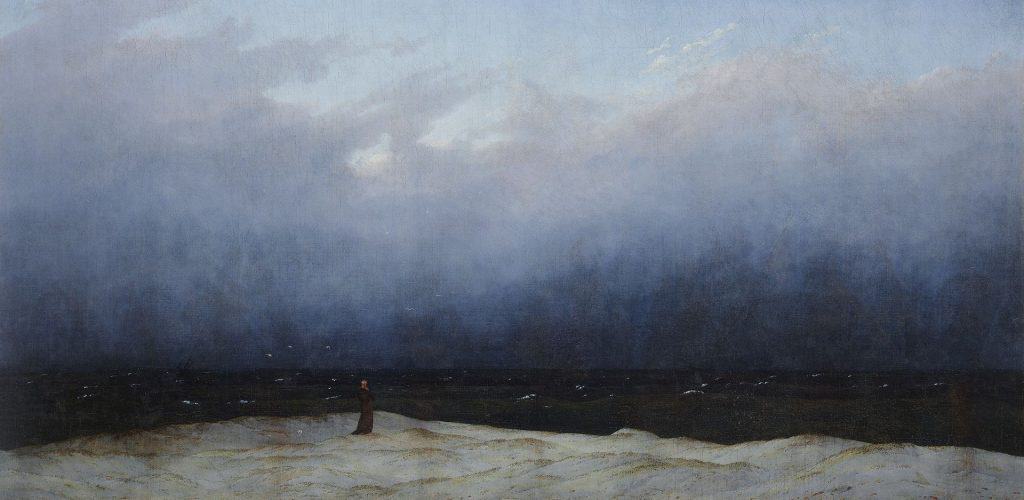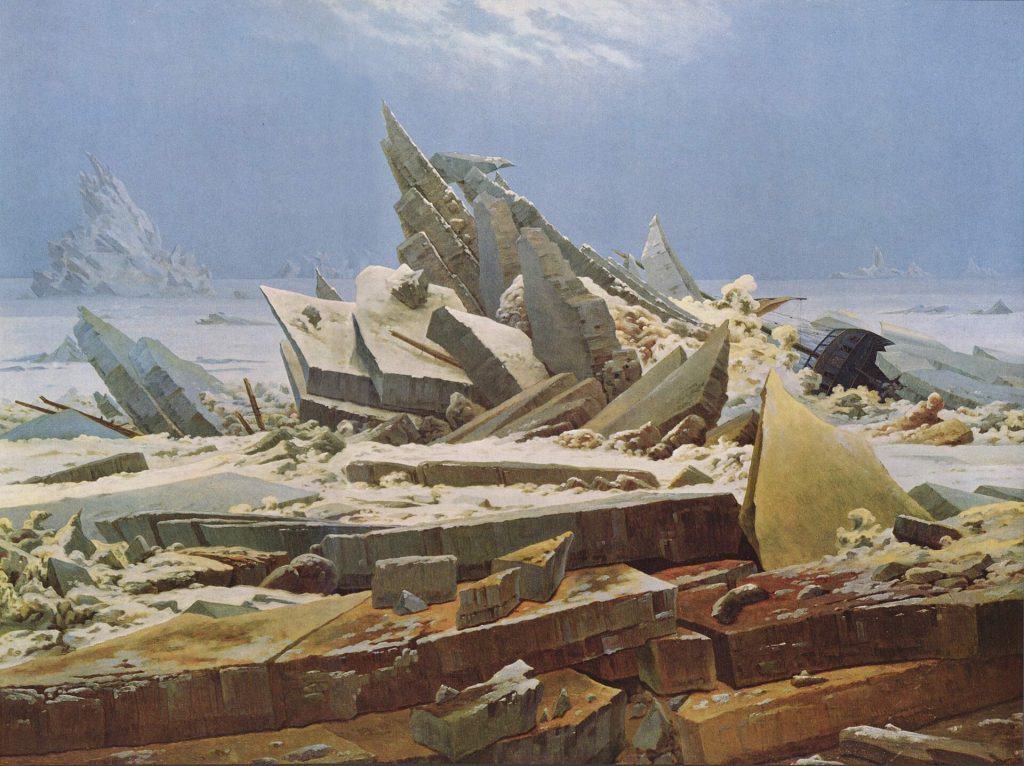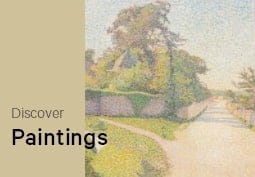Articles and Features
Celebrating 250 Years of Caspar David Friedrich: Romanticism, Resonance and Reflection
By Adam Hencz
We peer over the shoulder of a solitary figure, absorbed in the vastness of nature. The man, his back turned to us, stands atop an unseen crag, enveloped by a boundless sea of fog, lost in contemplation of the uncharted landscape.
This iconic painting, the Wanderer above the Sea of Fog by German Romantic landscape painter Caspar David Friedrich, is emblematic of his entire oeuvre.
With frequent elements like barren trees, Gothic ruins, and solitary figures, Friedrich’s work is rich in symbolism with themes of mortality, transcendence, and the sublime.
As art institutions celebrate the 250th birthday of Caspar David Friedrich across the globe, we delve into his signature works, talk about how his themes resonate in today’s world, and share events on the occasion of his anniversary.
Caspar David Friedrich’s Life, Work, and Iconic Paintings
Born on September 5, 1774, in Greifswald, Pomerania (now Germany), and passing away on May 7, 1840, in Dresden, Saxony, Friedrich was a cornerstone of German Romanticism. His works, characterized by their contemplative nature and the striking interplay of light and shadow, hold a unique place in art history.

Early life and formative years
Friedrich’s early life in Greifswald, a town on the Baltic Sea, significantly influenced his artistic direction. His formative years were marked by personal tragedies, having lost his mother when he was seven and two sisters to childhood illnesses. At the age of thirteen, he witnessed his brother fall through the ice of a frozen lake and drown, an event that haunted him for the rest of his life. This connection with mortality and the divine is evident in his works, which often evoke a sense of melancholy, introspection, and awe.
In 1794, he moved to Copenhagen for a brief period to continue his studies at the Fine Arts Academy. His time there was pivotal in shaping his artistic vision. Despite its lack of a formal painting course, the academy exposed him to progressive ideas and techniques. It was here that he developed his distinctive approach to landscape painting, focusing on the spiritual and metaphysical aspects of nature.
He returned to Germany after four years of apprenticeship and a brief period in Berlin and settled permanently in Dresden in 1798.
Caspar David Friedrich’s signature paintings
Among his most famous paintings are “The Monk by the Sea” (1808-1810), “Wanderer above the Sea of Fog” (1818), and “The Abbey in the Oak Wood” (1808-1810). Each of these works exemplifies Friedrich’s skill in conveying emotion and philosophical depth through landscape.

The Monk by the Sea
“The Monk by the Sea” is a masterpiece of minimalism, with vast expanses of color and a sense of awe and humility. The painting breaks traditional landscape composition, creating a feeling of vastness and isolation.
Wanderer above the Sea of Fog
“Wanderer above the Sea of Fog” is particularly significant for its portrayal of a lone figure against a tumultuous landscape. This painting encapsulates Friedrich’s interest in the metaphysical dimension of nature, as well as his subtle political statements.

The Abbey in the Oak Wood
“The Abbey in the Oak Wood” is a study in muted colors and depicts the ruins of a Gothic abbey amid barren trees. It showcases Friedrich’s use of negative space and his ability to evoke feelings of loss and longing.
Influence on Modern and Contemporary Practices
Caspar David Friedrich’s art is a profound investigation into humanity’s relationship with nature. His works are more than just representations of landscapes; they are explorations of the human spirit’s deep connection with the natural world.
A hallmark of Friedrich’s paintings is the inclusion of human figures, often seen from behind, gazing into the distance. These figures, known as “Rückenfigur,” serve as stand-ins for the viewer, inviting them to partake in the contemplative experience.
Today, Friedrich’s exploration of humanity’s connection with nature found new relevance. His emphasis on the emotional and spiritual dimensions of landscapes has influenced contemporary artists who seek to express the complexities of human experience through natural imagery. Friedrich’s work speaks to the modern viewer’s concerns about the environment and our place within it, reflecting a longing for harmony with nature.
Caspar David Friedrich’s 250th Anniversary: Events & Exhibitions
2024 marks a momentous year in the art world as it celebrates the 250th anniversary of the birth of Caspar David Friedrich. This milestone is being commemorated through a series of events and exhibitions across Germany, from a retrospective in Hamburg to thematic shows in cities significant to Friedrich’s life and work, such as Dresden, Berlin, and his birthplace, Greifswald.

Hamburger Kunsthalle: Caspar David Friedrich. Art for a New Age
The Hamburger Kunsthalle is presenting a major exhibition featuring 60 paintings and 100 drawings by Friedrich, and it is a profound contemporary reflection of the themes expressed in the Romantic era.
Including works like “Wanderer over the Sea of Fog” and “The Arctic Sea,” the exhibition also showcases a wide range of artistic mediums like paintings, drawings, installations, and video works that reflect the changed awareness of nature in times of crisis. These contemporary works engage with Friedrich’s themes, such as the sublimity of landscapes and the political implications of landscape art.
The exhibition offers a dual perspective: it looks back at Caspar David Friedrich’s transformation of the human-nature relationship in the early 19th century and forward to contemporary artists’ responses to environmental crises and reinterpretations of Friedrich’s themes.
Dresden: The Heart of Romanticism
In Dresden, where Friedrich spent a significant portion of his life, the celebration includes a series of exhibitions showcasing his influence on Romanticism. The Albertinum is highlighting major works of the 19th century by Friedrich and his contemporaries, fostering a dialogue between his work and modern and contemporary pieces.
Additionally, the Kraszewski Museum’s exhibition explores the interplay between German and Polish Romanticism, while the Kügelgenhaus – Museum of Romanticism in Dresden is focusing on female painters of the era of Friedrich.
Berlin: Infinite Landscapes
The Alte Nationalgalerie in Berlin is hosting “Infinite Landscapes” from April 19 to August 4, 2024. This extensive exhibition, in collaboration with the Kupferstichkabinett, presents around 60 paintings and 50 drawings by Friedrich, offering a comprehensive retrospective of his work.
It’s a significant event, considering Berlin’s role in Friedrich’s early acclaim and the Alte Nationalgalerie’s substantial collection of his works.
Greifswald: Friedrich’s Hometown Celebrations
Greifswald, Friedrich’s birthplace, has organized a year-long program that includes over 160 events. These range from special exhibitions like “Caspar David Friedrich. Lifelines” at the Pomeranian State Museum, showcasing the museum’s extensive inventory of Friedrich’s work, to “Caspar David Friedrich: The Hidden Life of Pictures” at the Caspar David Friedrich Centre.
The program also includes interactive activities inspired by Friedrich’s hikes, allowing visitors to engage creatively with his life and era.
Relevant sources to learn more
More articles from Artland Magazine:
The Year Ahead: the Art World in 2024 – Major Fairs, Trends & Exhibitions
Skagen Painters: The Art of Capturing Light
The Most Famous Art Movements and Styles
Other relevant sources:
Learn more about CASPAR DAVID FRIEDRICH. Art for a New Age at the Hamburger Kunsthalle through April 1st, 2024
Learn more about Caspar David Friedrich. Where it all started at the Albertinum in Dresden from August 24, 2024 to January 4th, 2025
Learn more about Caspar David Friedrich: Infinite Landscapes at the Alte Nationalgalerie in Berlin from April 19th to August 4th, 2024
Discover and Buy Artworks for Sale



